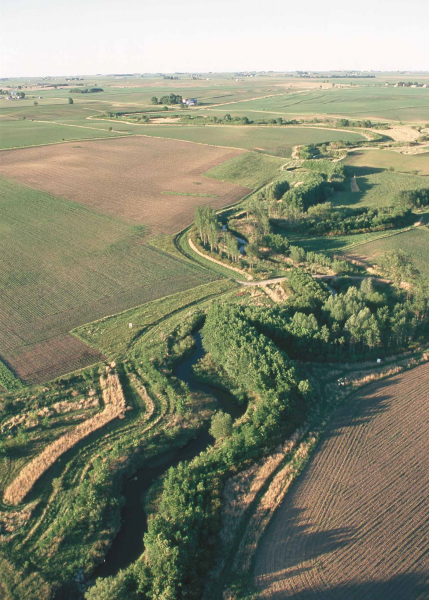Code
F01
Year of Issue
none
Sector
Forest
The complete description of the NWRM
| Attachment | Size |
|---|---|
| f1_-_forest_riparian_buffers.pdf | 702.93 KB |
Summary
Riparian buffers are treed areas alongside streams and other water bodies. While most commonly associated with set asides following forest harvest, riparian buffers can also be found in urban, agricultural and wetland areas. By preserving a relatively undisturbed area adjacent to open water, riparian buffers can serve a number of functions related to water quality and flow moderation. The trees in riparian areas can efficiently take up excess nutrients and may also serve to increase infiltration. Riparian buffers serve to slow water as it moves off the land. This can decrease sediment inputs to surface waters.
Illustration(s)
 |  |
Riparian buffer Source: | ...
Benefit Table
Possible benefits with level
| Benefits | Level | |
|---|---|---|
|
BP1 - Store runoff
|
Medium
|
|
|
BP2 - Slow runoff
|
Medium
|
|
|
BP4 - Slow river water
|
Low
|
|
|
BP5 - Increase evapotranspiration
|
Low
|
|
|
BP6 - Increase infiltration and/or groundwater recharge
|
Low
|
|
|
BP7 - Increase soil water retention
|
Low
|
|
|
BP8 - Reduce pollutant sources
|
Medium
|
|
|
BP9 - Intercept pollution pathways
|
Medium
|
|
|
BP10 - Reduce erosion and/or sediment delivery
|
High
|
|
|
BP11 - Improve soils
|
Low
|
|
|
BP12 - Create aquatic habitat
|
Medium
|
|
|
BP13 - Create riparian habitat
|
High
|
|
|
BP14 - Create terrestrial habitats
|
Low
|
|
|
BP16 - Reduce peak temperature
|
Medium
|
|
|
BP17 - Absorb and/or retain CO2
|
Low
|
|
|
ES1 - Water storage
|
Low
|
|
|
ES2 - Fish stocks and recruiting
|
Medium
|
|
|
ES3 - Natural biomass production
|
Low
|
|
|
ES4 - Biodiversity preservation
|
High
|
|
|
ES6 - Groundwater/aquifer recharge
|
Low
|
|
|
ES7 - Flood risk reduction
|
Low
|
|
|
ES8 - Erosion/sediment control
|
High
|
|
|
ES9 - Filtration of pollutants
|
Medium
|
|
|
ES10 - Recreational opportunities
|
Low
|
|
|
ES11 - Aesthetic/cultural value
|
Low
|
|
|
ES12 - Navigation
|
Low
|
|
|
PO1 - Improving status of biology quality elements
|
Medium
|
|
|
PO2 - Improving status of physico-chemical quality elements
|
Medium
|
|
|
PO3 - Improving status of hydromorphology quality elements
|
Medium
|
|
|
PO4 - Improving chemical status and priority substances
|
Low
|
|
|
PO6 - Improving chemical status
|
Low
|
|
|
PO7 - Prevent surface water status deterioration
|
Medium
|
|
|
PO8 - Prevent groundwater status deterioration
|
Low
|
|
|
PO9 - Take adequate and co-ordinated measures to reduce flood risks
|
Low
|
|
|
PO10 - Protection of important habitats
|
Medium
|
|
|
PO11 - Better protection for ecosystems and more use of Green Infrastructure
|
High
|
|
|
PO12 - More sustainable agriculture and forestry
|
Medium
|
|
|
PO13 - Better management of fish stocks
|
Medium
|
|
|
PO14 - Prevention of biodiversity loss
|
Medium
|
Case study(ies)